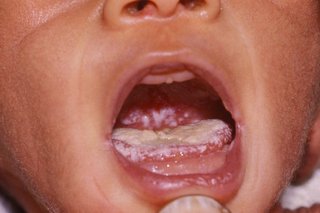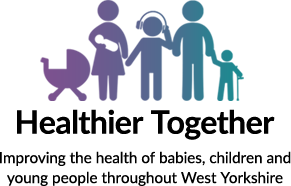My baby has thrush
It is normal for your baby's tongue to be white after a feed. If this wipes off easily and they are feeding well then this is due to milk coating the tongue and not thrush.
Thrush is caused by a yeast germ called Candida albicans. It can make your baby's mouth sore.
Signs and symptoms of thrush in your baby

- White patches on their tongue and inside their cheeks that won't rub off easily
- Their mouth seems sore and they may be reluctant to feed
- May be fretful, windy and more difficult to settle
- Your baby may also have a nappy rash with red spots which may be caused by the same yeast infection
Treatment
Mild thrush may get better by itself in 2 to 3 days. If your baby is over 4 months old then speak to your local community pharmacist about treatment you can buy over the counter. Speak to your GP for younger babies if you feel they need treatment, particularly if their feeding is being affected.
There are 2 main treatments available:
1. Nystatin can be given at any age. It has to be prescribed by a doctor. Give 0.5ml off a teaspoon after each feed if your baby is feeding around 8 times per day as the maximum daily dose is 4ml. If your baby feeds less than this you can give 1ml 4 times a day. Using the dropper may contaminate the whole bottle.
2. DAKTARIN® (Miconazole) 2% oral gel is available from your local community pharmacy for babies over 4 months of age. It is not licenced for children under 4 months due to the risk of choking. This medication may still be prescribed by your doctor after they have talked about the risks with you as it is very effective. You must not put it towards the back of your baby's mouth. Apply the gel gently, in small amounts to coat the mouth using a clean finger. Apply 4 times per day. It should not by given from a teaspoon or syringe.
When will it get better?
It should improve within 2 to 3 days of starting treatment. It may take up to 7 days for the infection to clear completely.
Top tips
- Apply thrush treatment after feeds
- Follow treatment instructions carefully
- Complete the full course of treatment
- Discard and replace all teats, dummies and nipple shields weekly
- Steam sterilise for 2 cycles or boil for 10 minutes all feeding equipment
Breastfeeding and thrush
If you are breastfeeding, you may experience thrush. It is extremely painful and affects both breasts at the same time. It may happen following a course of antibiotics.
It is important to ask your midwife or health visitor to check that your baby is latching onto the breast well. It can be easy to mistake painful breastfeeding due to poor attachment for thrush.
If the pain has not improved after position and attachment has been observed and support offered then consider thrush.
It is important to treat both mum and baby for thrush even if the other does not have symptoms. Otherwise, thrush may be passed between you.
Signs and symptoms
- You may have had sore, cracked nipples at first that have healed and breastfeeding was going well. You then experience a sudden onset of newly painful feeding.
- Your nipples may be itchy, burning, red, shiny and moist.
- The pain can be severe and continue after the feed has finished.
- Shooting or stabbing pain in your breasts.
- Cracked nipples that will not heal.
Treatment of the mother
- Use Miconazole (DAKTARIN® 2%) Cream which you can buy over the counter at a pharmacy
- Apply a small amount to your nipples and areola after each feed. There is no need to wash the nipples before feeding but you should gently wipe off any visible excess cream
- The frequency of use is more than usual as you need to apply it after every feed
- Apply after every breastfeed for 2 weeks
- It is important to continue the treatment for a whole week after you and baby are symptom free
- You should continue breast feeding whilst you are both being treated for thrush
Do not put Miconazole gel or Nystatin on your nipples as this will not treat thrush of the breasts
When will the pain go after treatment?
- For both you and your baby the pain should ease 2 to 3 days after treatment has started
- Some women experience pain again after about 7 to 10 days which usually improves by itself
Top Tips
- Follow treatment instructions carefully and complete the full course of treatment
- Change breast pads after each feed. Wash clothes that come into contact with your breasts on a hot wash
- Steam sterilise for 2 cycles or boil for 10 minutes all feeding equipment including pump parts
- Discard and replace weekly any teats, dummies or nipple shields
- Hot temperatures kill thrush, cold does not
- Do not freeze breast milk for later use during a thrush infection
- You can still breastfeed whilst being treated
Breast feeding support
- VIsit the West Yorkshire Healthier Together page on breastfeeding
- Find a local breast feeding support service by entering your postcode on this NHS site
- National Breastfeeding Helpline: 0300 100 0212
- La Leche League: 0345 120 2918
- National Childbirth Trust (NCT): 0300 330 0700
- The Breastfeeding Network provides breastfeeding support and information
- The Breastfeeding Network supporter line in Bengali and Sylheti: 0300 456 2421
- The Breastfeeding Network supporter line in Polish: W naszej ofercie nowy serwis z informacjami dotyczącymi karmienia piersią i emocjonalnym wsparciem mam w języku polskim. Zadzwoń pod numer 0300 100 0212 po czym wybierz 2
- Further information on thrush and breast feeding can be found on the Breastfeeding Support website



